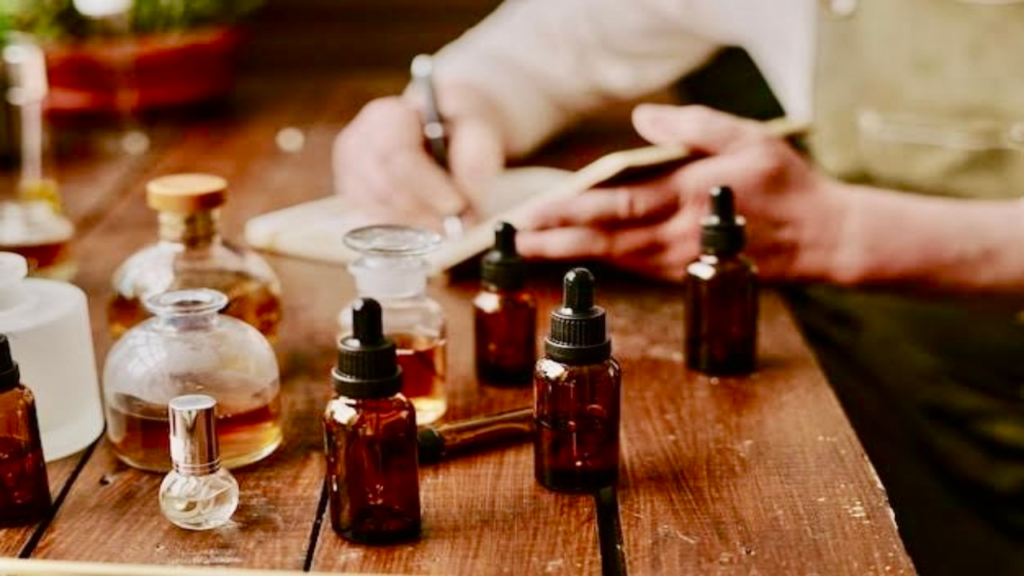Perfume has always been considered as art, creating various stories with the help of fragrances which are able to trigger feelings, memories and ambitions. The definition of perfume is much broader than the smell; it can include how the perfume looks like, how it is designed, and the feelings that the use of a scent delivers. To elaborate this proposition this work reveals the numerous layers of aesthetic considerations pertinent to perfume, which in terms of conceptuality, meaning, and imaginable journey are as far-reaching as any conventional art form.
1. The Art of Scent Creation:
a. The fragrance composition:
It is important to distinguish the aesthetics of perfume and the art of scent creation at the core of perfume aesthetics. There are different types of notes that make up the fragrance and the combination of these notes will create interdependent harmonious effects. These notes are typically categorized into three layers:
- Top Notes: It includes the first detected fragrances that appear to be fresh and subtle when the compound has been applied. Fruits, herbs and citrus are normally used mostly in this layer in order to have a first and strong statement.
- Middle Notes: These are sometimes referred to as the heart notes, and appear after the first Scent floods have cleared. Each determines the nature of the fragrance, and the stars here are present in the floral, spicy, and green zones.
- Base Notes: Exclusively worn after the particular fragrance has been deposited, these notes work in layers, and develop extra dimension. These base notes range from woods, musks and resins and it is important to get your choice right before finalizing on one type.
This three-elucidation structure is like the musical motifs where every note contributes some part while creating a harmonized and vivid fragranced symphony. Those are scents, and perfumers are musicians who arrange them into a concert, taking into account chemistry and aesthetic sense to create a certain mood and picture.
b. Concept Behind Designing Scents:
Different perfume houses create their fragrances from one or the other source such as nature, culture, history, and experience. The traditional concept of a perfume is not complete without a story. In the same vein, a perfume with notes of Mediterranean herbs might have lavender, rosemary, citrus: all these will remind the consumer of the sunny and calm Mediterranean landscapes.
Not to mention that most perfumers prefer using art and literature as their sources of inspiration. Perfumes may be intended to have something to do with a painting, represent a character from literature, or capture a certain experience. This artistry is a feature layer to the perfume, as it creates an individual emotional experience of the tale, different for every person.
2. Packaging and Presentation:
a. Bottle Design:
The sensory experience of a perfume does not start with the scent; that starts with the bottle. It is important that a perfume bottle embodies the aroma held inside the container. Aroma can be manly and smooth, slim and elegant, bulging and vintage, sophisticated and complex, and that shape, color and material can express it.
For instance, when contour lines are straight and smooth, this gives a sense that the related fragrance is new and trendy, whereas, when the design has curved features and much detail like antique feel, it will make the consumers relate it to a warm feeling.
b. Labeling and Branding:
Labels are an important part of what contributes to the look of a perfume. Graphic design components of branding, which include typeface and colors used and imagery used in a fragrance’s advertising carry a certain appeal. A thick, strapping font may grab the attention of a young reader, and a fine, flowing one, may look classy to some.
Branding also extends to the marketing and storytelling associated with a fragrance. Advertising campaigns that feature artistic visuals, emotional narratives, and captivating photography further enhance the perfume’s aesthetic appeal. These campaigns create an immersive experience that resonates with consumers, making them feel a part of the brand’s story.
Marketing is another area that is covered under branding when it comes to fragrances and branded stories of products. Those advertising campaigns that include artistic, emotional appeals and stunning visuals and photographs have the added bonus of making the perfume look even more attractive. These campaigns give the client a feeling that they are in the company, making them part of it through an engaging story.
3. Birth of Perfume and Effect of Context:
This for me is the essence of photojournalism and the foundation for individual style: the ability to convey a voice, message, or identity through photography, the freedom to experiment and grow, and the key to staying motivated and productive.
It is used as an image-enhancing product which represents or symbolizes an individual’s personality. It is even possible to say that people can choose such messages which can reflect their preferences, tempers, memories, etc. Scent may bring feelings of confidence, sexual attraction or relaxation, thus people can wear different masks.
Concerning cultural point of view, the aesthetic of perfume may also be diverse. End consumers might choose different fragrances depending on the culture, which may be caused by various plants, customs, practices, and beliefs. For example, oriental fragrances tend to appeal more to intense and deep, warm and spicy accords of oriental and resinous notes whereas western trends tend to be more directed towards clean, fresh, floral accords.
a. The Environment and Occasion:
The environment in which a scent is applied also determines the aspect related to beauty. Some of them will be perfect for definite events—floral and citrus notes, for instance, are considered appropriate for the daytime, and spices and woods – for the nighttime. Location is also important, whether it is a regular party or a glamorous occasion, the environment determines the manner in which a perfume will be perceived thus improving its appearance.
4. What is the Connection between Memory and Scent
a. Scent as a Memory Trigger:
Another very interesting issue concerning the question of perfume aesthetics is how deeply scent is rooted in memory. The olfactory system is connected to the limbic system, the brain center for feelings and memories. Such correlation implies that a single note of a scent controls desires taking an individual back to a certain period in life.
Many perfumes are designed with this concept in mind, aiming to create an emotional response through scent. For instance, a fragrance that reminds someone of their grandmother’s garden may evoke feelings of warmth and nostalgia, enhancing its aesthetic value. This interplay between scent and memory adds a deeply personal dimension to the aesthetics of perfume, making it a unique form of art that resonates on an individual level.
b. Cultural Memory and Heritage
Cultural anthropology is also expressed by perfumes wherein people’s culture and heritage in that certain area are considered. Oud from the Middle East or jasmine from India provides the scent of the respective countries and helps people feel they are in tune with their heritage, history. Incorporating culturally relevant ingredients and scent associations, other layers of aesthetic can be incorporated by perfumers for instance sovereignist worth.
5. A Walk Through the History of Perfume Aesthetics:
a. Historical Perspective over Perfumes:
The appearance of a perfume has been enhanced over the years. From the earliest civilizations, man has been using scents, for worship and as an offering to the gods. Like many other things of beauty, Egyptian pharaohs employ the fragrant oils to proclaim their rank of authority and might while Greeks and Romans apply the scents for both washing and as a promise of the attraction.
European Europe saw the beginning of artistic flourishes in perfumery during the renaissance where people started to invade wonderful arrangements combined with elaborate containers adorned the aristocrats. The 19th century and continuing into the 20th century introduced concept fragrances, which became emblematic of their respective eras as if they were aesthetical scripts.
b. Modern Trends in the Design of Perfumes:
Today, the perfume market has again experienced an identified trend in the fragmentation of Perfume Specialty Stores. These brands usually do not speed up work, hoping for a large number of visitors to view a large number of pages, but try to count on the attention of the audience to individual unconventional creativity that will be filled with narration. These fragrances are generally associated with a boutique style that has handmade bottles and packaging design, which give out a persona of each fragrance.
In addition, another decisive factor is the appearance of biodegradable and environmentally-friendly approaches which in turn had an impact on the design of perfumes. Thus, the trends have shifted toward simplicity and environmentally friendly packaging for products as well as natural ingredients for the products themselves. It also conforms to a fast-growing consciousness of the effects of the choice that consumers make on the earth.
6. The multi-sensory experience of perfume:
a. Scent and Other Senses:
Perfume aesthetics go further than the smell; they let other senses join the show. Shape and design of the bottle, the feel of the packaging material, sound of the sprayer is also part of the aesthetic of a fragrance. This five-sensory experience turns perfume into an object not only to use but to contemplate as a work of art at the same time.
b. Can we Make a Fragrance Even More Personal?
Polyfragrancedness or the layering of fragrances in which various scents combine to produce a special appeal is another factor of perfume appeal. This approach also enables individuals to choose their preference conveniently by identifying their personalities and creativity through scent. Most of the brands have flankers or advising how to mix fragrances for getting the best result and enjoy the process.
7. Future of perfume aesthetics:
a. Technological Advanced and Perfume:
It can be assumed that elegance developments will also control the advancement in perfume aesthetics. New directions in scent design processes like artificial intelligence and data analysis are altering things like the process and presentation of new fragrances. There is a heightened focus on consumer habits through the use of technological advancements hence, companies can create better and innovative kinds of fragrances.
In the same way, VR/AR is gradually making its way into the world of perfume with opportunities for creating immersive environments in which consumers can try scents. This technological integration can transform the aesthetic experience thus creating new ways in which people interact with aromas.
b. Gender-neutral scents:
One more tendency determining the appearance of perfumes in the future is the presentation of scents for any genders. Predominantly, the female consumers are transitioning from conventional gender associated fragrances, in favor of scents that embody their individuality as opposed to their sexual orientation. The change is forcing brands to create Commission de la Parfumerie scents that do not fit the traditional beauty standards, which advocates for diversity and plurality.
Conclusion:
Perfume is at the same time art, emotion, and personal statement reflecting the beauty of the world. Because embracing fragrances means so much more than simply a collection of scents, the construction of each scent is a rich tapestry, and even the exterior of the bottles and the packaging themselves offer an experience. And prolonging with the development of the perfume industry in terms of its ecological approach, the use of the advanced technologies, cultural diversification, the aesthetic aspect of the perfume and scents will stay being one of the key features that contribute to the consumer’s attraction to the product. Lastly, perfume is more than a fragrance, it is an art that helps people to discover, share and learn about themselves and the world through feeling and experiences related to the act of fragrance

